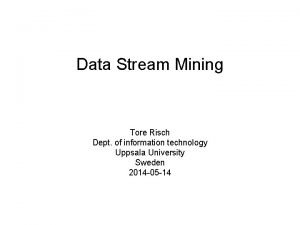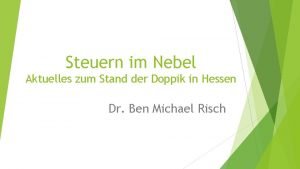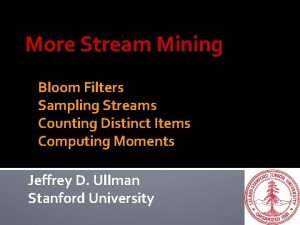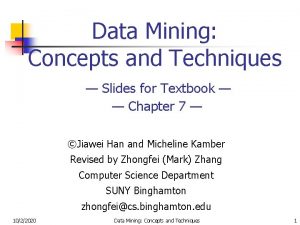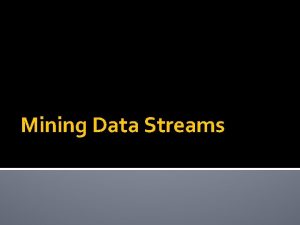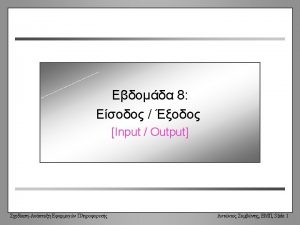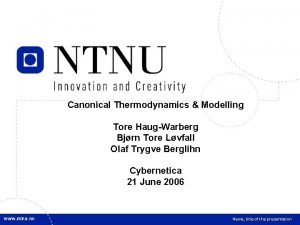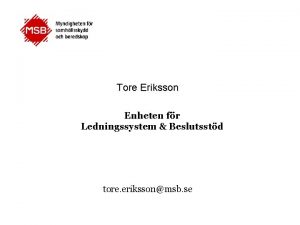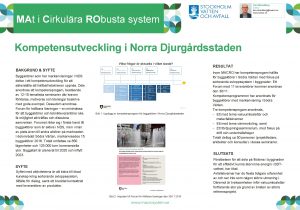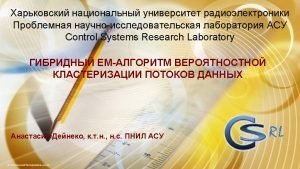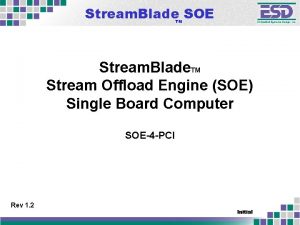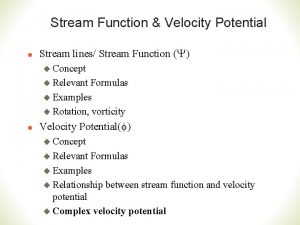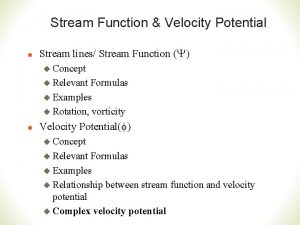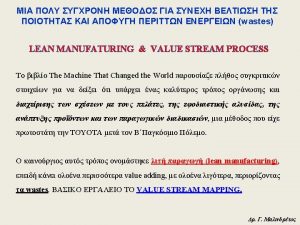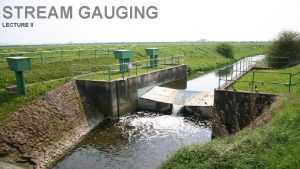Data Stream Mining Tore Risch Dept of information





























- Slides: 29

Data Stream Mining Tore Risch Dept. of information technology Uppsala University Sweden 2014 -05 -14

New applications • Data comes as huge data streams, e. g. : - Satellite data Scientific instruments, e. g. colliders Social networks Stock data Process industry Traffic control Patient monitoring

Enormous data growth • • • Read landmark article in Economist 2010 -02 -27: http: //www. economist. com/node/15557443/ The traditional Moore’s law: – Processor speed doubles every 1. 5 years Current data growth rate significantly higher – Data grows 10 -fold every 5 year, which about the same as Moore’s law Major opportunities: – spot business trends – prevent diseases – combat crime – scientific discoveries, the 4 th paradigm (http: //research. microsoft. com/en -us/collaboration/fourthparadigm/) – data-centered economy Major challenges: – Information overload – Scalable data processing, ‘Bigdata management’ – Data security – Data privacy

Too much data to store on disk ÞNeed to mine streaming data

Mining a swift data river Cover, Economist 14 pages thematic issue 2010 -02 -27

Mining streams vs. databases • Data streams dynamic and infinite in size – – Data is continuously generated and changing Live streams may have no upper limit A live stream, can be read only once (‘Just One Look’) The stream rate may be very high • Traditional data mining does not work for streaming data: – Regular data mining based on finite data collections stored in files or databases – Regular data mining done in batch: • read (access) data in collection several times • analyze accessed data • store results in database (or file) – For example, store for each data object what cluster it belongs to

Data stream mining vs. traditional data mining • Live streams grow continuously – The system cannot read streams many times as with traditional data mining • Live streams mining must be done on-line – Not traditional batch processing • Live streams require main memory processing – To keep up with very high data flow rates (speed) • Live streams must be mined with limited memory – Not load-analyze as traditional data mining – Iterative processing of statistics • Live streams must keep up with very high data flow volumes – Approximate mining algorithms – Parallel on-line computations

Streams vs. regular data • Data stream mining requires iterative aggregation: – Read data tuples iteratively from input stream(s) • E. g. measured values • Do not store read data in database – Analyze read tuples incrementally – Keep partial results in main memory • E. g. sum and count – Continuosly emit incremental analyzed resuls • E. g. running average by dividing sum with count • Result of data stream mining is derived stream – Continuously produced by emit – Can be stored as continuously changing database

Streams vs. regular data • Stream processing should keep up with data flow – Make computations so fast that they keep up with the flow (on average) – Should not be catastrophic if if miner cannot keep up with the flow: • Drop input data values • Use approximate computations such as sampling • Asynchronous logging in files often possible – At least of processed (reduced) streaming data – At least during limited time (log files)

Requirements for Stream Mining • Single scan of data, – because of very large or infinite size of streams. – because it may be impossible or very expensive to reread the stream for the computation • Limited memory and CPU usage – because the processing should be done in main memory despite the very large stream volume • Compact continuously evolving representation of mined data – It is not possible to store the mined data in database as with traditional data mining – A compact main memory representation of mined data needed

Requirements for Stream Mining • Allow for continuous evolution of mined data – Traditional batch mining static mined data – Continuous mining makes mined data into a stream too =>Concept drift • Often mining over different kinds of windows of streams – E. g. sliding or tumbling windows – Windows of limited size – Often only statistics summaries needed (synopses, sketches)

Data Stream Management Systems (DSMS) • Data. Base Management System (DBMS) – General purpose software to handle large volume persistent data (usually on disk) – Important tool for traditional datamining • Data Stream Management System (DSMS) – General purpose software to handle large volume data streams (often transient data) – Important tool for data stream mining

Data Base Management System SQL Queries DBMS Query Processor Data Manager Meta – data Stored Data

Data Stream Management System Continuous Queries (CQs) DSMS Query Processor Data streams Data & Stream Manager Meta – data Stored Data streams

Stream windows • Limited size section of stream stored temporarily in DSMS – ’Regular’ database queries can be made over these windows • Need window operator to chop stream into segments • Window size (sz) based on: – Number of elements, a counting window • E. g. last 10 elements – i. e. windows has fixed size of 10 elements – A time window • E. g. elements last second – i. e. windows contains all event processed during the last second – A landmark window • All events from time t 0 in window – c. f. growing log file – A decaying window • Decrease importance of measurement by multiplying with factor l • Remove when importance below threshold

Stream windows • Windows may also have stride (str) – Rule for how fast they move forward, • E. g. 10 elements for a 10 element counting window – A tumbling window • E. g. 2 elements for a 10 element counting window – A sliding windows • E. g. 100 elements for a 10 element counting window – A sampling window • Windows need not always be materialized – E. g often sufficient to keep statistics materialized

Continuous (standing) queries over streams from expressways Schema for stream Car. Loc. Str of tuples: Car. Loc. Str(car_id, /* unique car identifier */ speed, /* speed of the car */ exp_way, /* expressway: 0. . 10 */ lane, /* lane: 0, 1, 2, 3 */ dir, /* direction: 0(east), 1(west) */ x-pos); /* coordinate in express way */ CQL query to continuously get the cars in a window of the stream every 30 seconds: SELECT DISTINCT car_id FROM Car. Loc. Str [RANGE 30 SECONDS]; Get the average speed of vehicles per expressway, direction, segment each 5 minutes: SELECT exp_way, dir, seg, AVG(speed) as speed, FROM Car. Seg. Str [RANGE 5 MINUTES] GROUP BY exp_way, dir, seg; • http: //www. cs. brandeis. edu/~linearroad/

Denstream • Streamed DBScan • Published: 2006 SIAM Conf. on Data Mining (http: //user. it. uu. se/~torer/Den. Stream. pdf) • Regular DBScan: – DBScan saves cluster memberships of static database per member object in database by scanning database looking for pairs of objects close to each other – Database accessed many times – For scalable processing a spatial index must be used to index points in hyperspace and answer nearest-neighbor queries

Denstream • Denstream – – One pass processing Limited memory Evolving clustering => not static cluster membership Indefinite stream => store cluster memberships not stored in database – No assumption of number of clusters • clusters fade in and fade out – Clusters of arbitrary shape allowed – Good at handling outliers

Core micro-clusters • Core point: ‘anchor’ in cluster of other points • Core micro-cluster: An area covering points close to (epsilon similar) a core point • Cluster defined as set of micro-clusters

Potential micro-clusters • Outlier o-micro-cluster – New point not included in any micro-cluster • Potential p-micro-cluster – Several clustered points not large enough to form a micro-cluster • When new data point arrives: 1. Try to merge with nearest p-micro-cluster 2. Try to merge with nearest o-micro-cluster • If so convert o-micro-cluster to p-micro-cluster 3. Otherwise make new o-micro-cluster

Decaying p-micro-cluster windows • Maintain weight Cp per p-micro-cluster • Periodically (each Tp time period) decrease weight exponentially by multiplying old weight with l • Weight lower than threshold => delete, i. e. decaying window • Decaying window of micro clusters

Dealing with outliers • o-micro-clusters important forming new evoving p-micro-clusters Þ Keep o-micro-clusters around • Keeping all o-micro-clusters may be expensive Þ Delete o-micro-cluster by special exponential pruning rule (decaying window) • Decaying window method proven to make # micro-clusters grow logarithmically with stream size – Good, but not sufficient for indefinite stream – Shown to grow very slowly though

Growth of micro-clusters

Forming c-micro-cluster sets • Regularly (e. g. each time period) the user demands forming current c-micro-clusters from the current p-micro-clusters • Done by running regular DBSCAN over the p-micro-clusters – Center of each p-micro-cluster regarded as point – Close when p-micro-clusters intersect => Clusters formed

Bloom-filters • Problem: Testing membership in extremely large data sets – E. g. all non-spam e-mail addresses • No false negatives, i. e. if address is in set then OK guaranteed • Few false positives allowed, i. e. a small number of spams may sneek through See http: //infolab. stanford. edu/~ullman/mmds/ch 4. pdf section 4. 3. 2

Bloom-filters • Main idea: – Assume bitmap B of objects of size s – Hash each object x to h in [1, s] – Set bit B[h] • Smaller than sorted table in memory: – 109 email addresses of 40 bytes => 40 GByte if set to be stored sorted in memory • Would be expensive to extend – Bitmap could have e. g. 109/8= 125 MBytes • May have false positives – Since hash function not perfect

Lowering false positives • Small bitmap => many false positives • Idea, hash with several independent hash functions h 1(x), h 2(x) and set bits correspondingly (logical OR) • For each new x check that all hi(x) are set – If so => match – Chance of false positives decrease exponentially with number of hi • Assumes independent hi(x) – hi(x) and hj(x) no common factors if i ≠ j

Books - Anand Rajaraman & J. Ullman: Mining of Massive Datasets http: //infolab. stanford. edu/~ullman/mmds. html - L. Golab and T. Özsu: Issues in Stream Data Management, SIGMOD Records, 32(2), June 2003, http: //www. acm. org/sigmod/record/issues/ 0306/1. golab-ozsu 1. pdf
 Tore risch
Tore risch Mining complex types of data in data mining
Mining complex types of data in data mining Ben michael risch
Ben michael risch Bloom filter for stream data mining
Bloom filter for stream data mining Mining multimedia databases in data mining
Mining multimedia databases in data mining Differentiate byte stream and character stream
Differentiate byte stream and character stream Information gain in data mining
Information gain in data mining Strip mining vs open pit mining
Strip mining vs open pit mining Strip mining before and after
Strip mining before and after Difference between strip mining and open pit mining
Difference between strip mining and open pit mining Difference between text mining and web mining
Difference between text mining and web mining You were the word at the beginning
You were the word at the beginning Tore håkon riple
Tore håkon riple Present participle for drink
Present participle for drink Bassin obstétrical définition
Bassin obstétrical définition Pinagmulan ng wika na ibinatay sa bibliya
Pinagmulan ng wika na ibinatay sa bibliya Ilk töre romanı
Ilk töre romanı Tore solheim
Tore solheim Data reduction in data mining
Data reduction in data mining What is kdd process in data mining
What is kdd process in data mining What is missing data in data mining
What is missing data in data mining Concept hierarchy generation for nominal data
Concept hierarchy generation for nominal data Data reduction in data mining
Data reduction in data mining Data reduction in data mining
Data reduction in data mining Shell cube in data mining
Shell cube in data mining Data reduction in data mining
Data reduction in data mining Arsitektur data mining
Arsitektur data mining Data mining dan data warehouse
Data mining dan data warehouse Crm data warehouse models
Crm data warehouse models Mining complex data objects
Mining complex data objects
